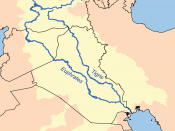ANT 350 - Ancient Civilizations Prof. Susan Smiley 350 essay mcu4 - p� PAGE �4�
Urbanization and a centralized governing body are two key factors in determining a civilization. These large dense populations also known as cities are characterized by their interdependence and specialization with surrounding rural inhabitants (Scarre 2003:6). People gathered to a central place where specialized craftsmen could meet and exchange goods and services with rural inhabitants and each other. Within the limits of these centralized locations, the power of a governing body set in place systems of rules and laws to be obeyed by the people living within the limits of the city, those that lived just outside of it, and visitors as well. These rules were put in place to create some sort of organization so that both the internal and external survival of the city will be successful.
Mesopotamia, the land or area in the Middle East presently known as Iraq, is often referred to as the first civilization from which came many early cities.
Situated between the Tigris and Euphrates rivers, this early civilization covered a vast area that enabled the cultures to develop advancements in many areas of knowledge. With such a diverse land to manage, Mesopotamia was forced to come up with new ways to improve, and therefore became more technologically advanced. They showed progression in agricultural skills and techniques, with the Ubaid culture developing irrigation for farming due to the lack of rainfall in the region (Smiley 2010: unit 2). Another major documented advancement from the Mesopotamian region is writing. They used clay to create tablets that could be imprinted with their symbols, heated and preserved for thousands of years. Archaeologists have been able to discover and decipher a large number of clay tablets from this area which leads us to...


